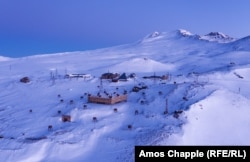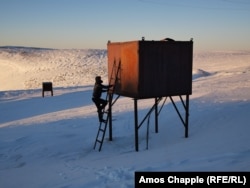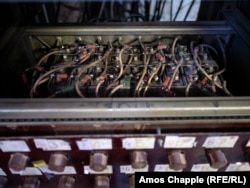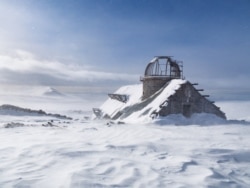This is the Cosmic Ray Research Station on Armenia's Mount Aragats. The station sits at an altitude of 3,200 meters -- more than one-third the height of Mount Everest.
The site was constructed in 1943 as a place for top-secret research into atomic reactions that could be harnessed for nuclear weapons. Now it provides insight into thunderstorms and cosmic rays -- one of the universe's most compelling mysteries.
The only way visitors can reach the base in winter is via a 15-kilometer climb through puffy snow.
Mountain guide Arshak Mkrtchyan cuts a trail to the station in snowshoes under a deep blue sky and a temperature around minus 22 degrees Celsius.
One of the research station's technicians being taken down by snowmobile after his one-month winter shift ended. He will have a month's rest at home before heading back up the mountain.
When we arrive at the station at sunset, the wind is shrieking across the plateau and the temperature has plummeted dangerously.
But inside it's surprisingly cozy. Technicians Edik Arshakian (left) and Gurgen Jabaryan are tasked with monitoring the scientific equipment at the center...
...while Gohar Hovhannisian takes care of the food. She describes being somewhat trapped during the winter: "I can't go outside for a full month; I'd sink up to my waist out there."
Hovhannisian presides over an enormous kitchen built during the Soviet period, when scores of technicians were required to monitor and maintain rudimentary equipment. In winter she cooks mostly for just the two men and herself.
Tunnels beneath the facility allow for easy trips between the buildings during winter. Cats stalk the tunnels for mice.
Dotted in and around the center, "scintillators" (above) record incoming cosmic rays as they strike chunks of clear plastic inside, sparking tiny flashes of light.
Soviet-era mosaics illustrating cosmic rays striking the Earth's atmosphere adorn these walls at the station. The confusingly named "rays" are, in fact, mysterious atom fragments that zip through outer space at nearly the speed of light.
When the specks streak through the Earth's atmosphere they strike atoms and scatter them like snooker balls. These particles have the power to cut through people and things, and are sometimes blamed for corrupting digital memory and crashing computers.
The particles are one of the main obstacles to interplanetary travel, and their effects on astronauts and pilots are the subject of continued study.
Jabaryan climbs into one of the steel boxes around the station that house scintillators. High-altitude bases like Aragats are exposed to far higher doses of the cosmic specks than at sea level, since the Earth's atmosphere serves as a protective blanket.
Jabaryan at the computer where recordings from sensors around the base are fed and sent to physicists in Yerevan. Aragats is part of a network of sites around the world studying cosmic rays and is linked to research stations as far away as Costa Rica and Indonesia.
As well as studying cosmic rays, the center is equipped with sensors that can record lightning strikes for kilometers around. In 2018, researchers using the sensors on Aragats found that thunderclouds were linked to drastic spikes in radiation that may affect passengers and crew aboard aircraft.
Soviet-era electronics abound at the base. Amid the economic turmoil that followed the collapse of the Soviet Union, the Aragats station was kept alive by state funds and donations from the Armenian diaspora community, which continue today.
An observatory half built, then abandoned by the Soviets sits 200 meters away from the station.
Although Aragats is a thriving research site in summer, when visitors can arrive by car, through the long winter months it's a lonely place that's physically cut off from the world.
Jabaryan photographing Mount Ararat -- 90 kilometers away in Turkey -- at sunrise.
He jokes that his favorite part of working at the site is "when the snowmobile comes to pick me up at the end of the month." But the isolation of this mountain station is a worthy sacrifice for science since, as Hovhannisian says, "we're above civilization -- the cosmic particles arrive clear and pure here since there's nothing to disturb them."

























